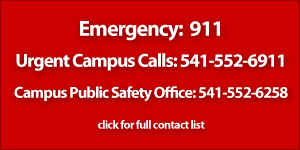 Having a good time drinking and smoking in the dorms causing a little ruckus, three underage freshmen hear three firm raps from the other side of the door, one knock for each of them. “Campus Public Safety open up.” Initial panic sets in and one student bolts under the bed, another in the closet, leaving one confused freshmen wondering if he could hide underneath the mound of dirty laundry in the corner of his friends room. The students eventually come out of hiding to be greeted by two CPS officers accompanied by two members of the Ashland Police Department, citations in hand. This according to an SOU student present who wished to remain anonymous.
Having a good time drinking and smoking in the dorms causing a little ruckus, three underage freshmen hear three firm raps from the other side of the door, one knock for each of them. “Campus Public Safety open up.” Initial panic sets in and one student bolts under the bed, another in the closet, leaving one confused freshmen wondering if he could hide underneath the mound of dirty laundry in the corner of his friends room. The students eventually come out of hiding to be greeted by two CPS officers accompanied by two members of the Ashland Police Department, citations in hand. This according to an SOU student present who wished to remain anonymous.
This story is well known among many students at SOU who have stories of their own about seeing police on campus or at their dorm room while committing an infraction.
According to Campus Public Safety (CPS) at SOU, their main task is ensuring the safety of students, faculty and guests on campus, while also enforcing University policy. While CPS officials say they strive to maintain these tasks on their own often times they must involve the Ashland Police Department (APD) in extreme situations such as when a crime is committed on campus. The cooperation of these two departments has a significant impact on SOU’s campus community. So how does CPS and APD interact with one another and how deep does this relationship go?
“APD and CPS’s relationship is extremely valuable,” said CPS officer Brian Nordahl. Nordahl continues to explain that CPS generally handles most calls themselves and only involves APD with criminal behavior or incidents involving student safety such as drug or alcohol abuse which transpire on campus. Violations to campus policy are usually handled exclusively by CPS the exception being when the violator, whether they are a student or not, is “highly uncooperative.”
It should be noted that APD usually only comes onto campus when requested by CPS or the school itself, but occasionally will venture onto University grounds when their own investigations require. Nordahl explains “When these instances happen APD is good about coordinating with CPS and having us assist them though it is not required, should they say, be investigating a more sensitive case.”
When CPS and APD are both involved in on campus situations Nordahl explains that the question of whose in charge is rarely an issue. Officially APD is in charge of a scene just as the Ashland Fire Department would be if called. However APD almost always defers to CPS’s request of how an on campus situation is handled.
So what are the most common things that students are likely to see APD and CPS on campus?
According to CPS’s 2014 Campus Public Safety Report, at 80% the most prevalent violations committed on campus involve drug and alcohol related incidences. These don’t necessarily require APD’s presence, however they are often present, particularly when a minor is involved. Other than this officers are most likely to be seen on campus for public disturbances or reported burglaries which are rare.



